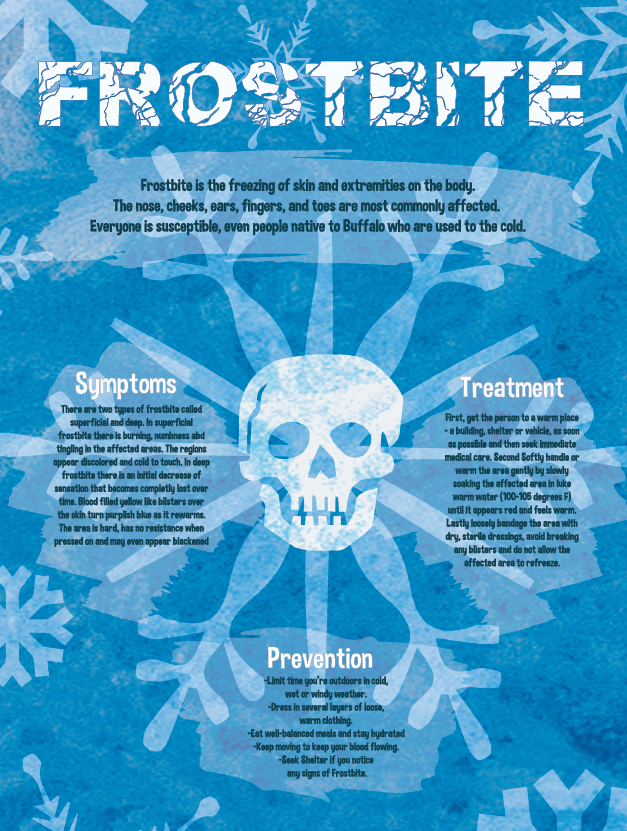By: Mike Rickard II You’ve probably heard the saying, “Everybody talks about the weather, but nobody does anything about it.” While we can’t do anything about the weather, we can do something about frostbite, a dangerous condition caused by exposure to cold temperatures. Frostbite can cause ...
Info-Graphic by Ally Glowacki
You’ve probably heard the saying, “Everybody talks about the weather, but nobody does anything about it.” While we can’t do anything about the weather, we can do something about frostbite, a dangerous condition caused by exposure to cold temperatures. Frostbite can cause long-term damage, ranging from frostbite-related arthritis to the amputation of areas affected by frostbite.
Sometimes it’s easy to forget to protect ourselves from the ravages of cold weather. We may be in a rush and forget to bring our gloves or even go out without a warm coat. In other cases, the weather can change quickly, going from moderate to extreme temperatures. It doesn’t take much exposure to the cold before frostbite occurs, especially when there are high winds.
Preventing Frostbite
1. Limit your exposure to the cold. Naturally, the best thing to do is to limit your exposure to extreme cold, but that is not always an option. The weather can change quickly so it’s best to be prepared for extremes. It’s better to go out with adequate weather gear and find you don’t need it than to go out without it and need it later.
2. Layer yourself. One of your best defenses against the cold is to layer yourself in warm clothing and the right combination of materials. Don’t wear clothing that is tight as it restricts blood flow which in turn can increase the chance of frostbite.
The Children’s Hospital of Pittsburgh recommends the following method for layering yourself:
Layer 1 – wear clothes that will keep moisture away from the skin. Thermal underwear, moisture-reducing winter sportswear, cotton socks and mitten and glove liners are good items to use. The first layer, like the other layers, should not be so tight that circulation is impeded.
Layer 2 – wear loose clothing that is intended to resist dampness and maintain body temperature. Heavy pants, sweaters and sweatshirts are good items for layer two.
Layer 3 – wear tightly woven moisture-resistant outerwear. Moisture-resistant coats and jackets, hats, scarves, gloves and mittens and boots are good third layer items.
Another benefit of layering yourself is that you can remove layers as necessary. If the weather improves you can remove a layer.
3. Drink plenty of fluids but avoid alcohol and limit caffeine intake before going outside.
4. Carry emergency supplies in your motor vehicle such as extra clothing, handwarmers, and blankets. Chemical handwarmers can be helpful in emergency situations but be sure to follow the instructions carefully.
5. Let people know when you are going out and carry your phone with you.
6. Keep moving. Keep your blood circulating, but don’t tire yourself out.
7. Look for signs of frostbite (see below).
Signs of Frostbite
According to WebMD, watch out for the following signs that could mean frostbite: Exposed skin that starts to look red. It might throb, prickle, burn, or sting. These are usually the first signs. As well as areas that look yellowish-gray or white, waxy, or feel too firm, lack of feeling in a part of your body that’s exposed to cold.
Conditions that Can Worsen Your Chance of Frostbite
According to the Mayo Clinic,certain things can increase the likelihood of frostbite, such as medical conditions that affect your ability to feel or respond to cold, such as dehydration, excessive sweating, exhaustion, diabetes and poor blood flow in your limbs, alcohol or drug abuse, smoking, fear, panic or mental illness, if it inhibits good judgment or hampers your ability to respond to cold or previous frostbite or cold injury. Infants or older adults, both of whom may have a harder time producing and retaining body heat are at higher risk as well. If you are at a high altitude, which reduces the oxygen supply to your skin this also increases your chance of frostbite.
Treating Frostbite
Frostbite can have serious consequences so if you believe you or a loved one has suffered frostbite, contact a medical professional immediately. While you are waiting, you can remove cold and/or wet clothing, dress the person in loose clothing that is warm and dry. However, you’ll want to avoid rubbing or bumping the frostbitten areas or pop any blisters the frostbite has caused. Also do not apply direct heat to the area by using electric blankets or hair dryers.
If you live in a cold weather climate or plan on visiting one, it is essential that you know these fundamentals. You can find more detailed information on preventing frostbite at the following sites:
The Mayo Clinic https://www.mayoclinic.org/diseases-conditions/frostbite/symptoms-causes/syc-20372656
Wilderness Medical Society: https://www.wemjournal.org/article/S1080-6032(14)00280-4/fulltext#s0015
WebMD: https://www.webmd.com/first-aid/understanding-frostbite-prevention##1

